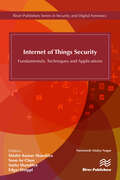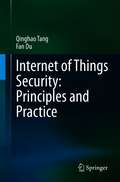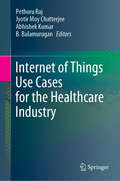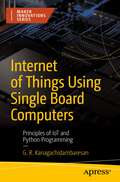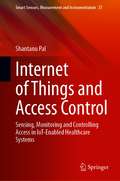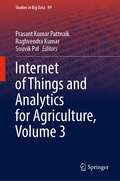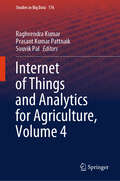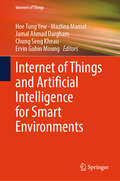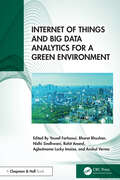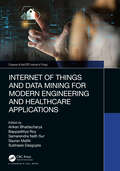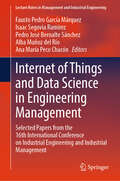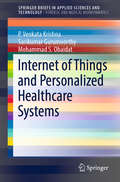- Table View
- List View
Internet of Things Projects with ESP32: Build exciting and powerful IoT projects using the all-new Espressif ESP32
by Agus KurniawanCreate and program Internet of Things projects using the Espressif ESP32. Key Features Getting to know the all new powerful EPS32 boards and build interesting Internet of Things projects Configure your ESP32 to the cloud technologies and explore the networkable modules that will be utilised in your IoT projects A step-by-step guide that teaches you the basic to advanced IoT concepts with ESP32 Book Description ESP32 is a low-cost MCU with integrated Wi-Fi and BLE. Various modules and development boards-based on ESP32 are available for building IoT applications easily. Wi-Fi and BLE are a common network stack in the Internet of Things application. These network modules can leverage your business and projects needs for cost-effective benefits. This book will serve as a fundamental guide for developing an ESP32 program. We will start with GPIO programming involving some sensor devices. Then we will study ESP32 development by building a number of IoT projects, such as weather stations, sensor loggers, smart homes, Wi-Fi cams and Wi-Fi wardriving. Lastly, we will enable ESP32 boards to execute interactions with mobile applications and cloud servers such as AWS. By the end of this book, you will be up and running with various IoT project-based ESP32 chip. What you will learn Understand how to build a sensor monitoring logger Create a weather station to sense temperature and humidity using ESP32 Build your own W-iFi wardriving with ESP32. Use BLE to make interactions between ESP32 and Android Understand how to create connections to interact between ESP32 and mobile applications Learn how to interact between ESP32 boards and cloud servers Build an IoT Application-based ESP32 board Who this book is for This book is for those who want to build a powerful and inexpensive IoT projects using the ESP32.Also for those who are new to IoT, or those who already have experience with other platforms such as Arduino, ESP8266, and Raspberry Pi.
Internet of Things Projects with ESP32: Build exciting and powerful IoT projects using the all-new Espressif ESP32
by Agus KurniawanCreate and program Internet of Things projects using the Espressif ESP32. Key FeaturesGetting to know the all new powerful EPS32 boards and build interesting Internet of Things projectsConfigure your ESP32 to the cloud technologies and explore the networkable modules that will be utilised in your IoT projectsA step-by-step guide that teaches you the basic to advanced IoT concepts with ESP32 Book DescriptionESP32 is a low-cost MCU with integrated Wi-Fi and BLE. Various modules and development boards-based on ESP32 are available for building IoT applications easily. Wi-Fi and BLE are a common network stack in the Internet of Things application. These network modules can leverage your business and projects needs for cost-effective benefits. This book will serve as a fundamental guide for developing an ESP32 program. We will start with GPIO programming involving some sensor devices. Then we will study ESP32 development by building a number of IoT projects, such as weather stations, sensor loggers, smart homes, Wi-Fi cams and Wi-Fi wardriving. Lastly, we will enable ESP32 boards to execute interactions with mobile applications and cloud servers such as AWS. By the end of this book, you will be up and running with various IoT project-based ESP32 chip. What you will learnUnderstand how to build a sensor monitoring loggerCreate a weather station to sense temperature and humidity using ESP32Build your own W-iFi wardriving with ESP32. Use BLE to make interactions between ESP32 and AndroidUnderstand how to create connections to interact between ESP32 and mobile applicationsLearn how to interact between ESP32 boards and cloud serversBuild an IoT Application-based ESP32 boardWho this book is forThis book is for those who want to build a powerful and inexpensive IoT projects using the ESP32.Also for those who are new to IoT, or those who already have experience with other platforms such as Arduino, ESP8266, and Raspberry Pi.
Internet of Things Security and Data Protection (Internet of Things)
by Sébastien ZieglerThis book provides an overview of the most recent developments in Internet of Things (IoT) security and data protection. It presents the results of several international research projects addressing this topic from complementary angles. It starts by analyzing the main privacy and security threats on IoT, as well as the evolution of data protection norms, such as the European General Data Protection Regulation (GDPR), and their impact on IoT. Through a comprehensive and systematic approach, the contributors present new perspectives on IoT & Cloud Computing security requirements. They discuss the most recent approach to support trusted IoT, including new models of privacy risk assessment, labeling and certification, and contractual tools (such as Privacy PACT). Practical implementations, such as in the European Large Scale Pilots on IoT for Smart Cities (Synchronicity), are presented, explaining how they address security, privacy and data protection. Finally, innovative models to secure IoT systems are presented for the network and end-nodes security, including network threats analysis.
Internet of Things Security: Architectures and Security Measures (Advances in Computer Science and Technology)
by Chuan-Kun WuThis book presents a systematic and comprehensive overview for IoT security. It first introduces architecture approaches for IoT and IoT security, describing the security techniques for different layers in the IoT security architecture. It also provides an in-depth analysis on the difference between IoT security and traditional system and data security. It is commonly known that information security includes data confidentiality, data integrity, and availability, and that measures include non-repudiation and access control. However, in practical IoT system construction, many more security measures need to be carefully considered. As such, this book presents around 60 different security measures, mainly focusing on the sensor layer of IoT. These security measures can serve as a source of reference for IoT system construction, as well as IoT security standard making.
Internet of Things Security: Challenges, Advances, and Analytics
by Chintan Patel Nishant DoshiMost of the devices in the Internet of Things will be battery powered sensor devices. All the operations done on battery powered devices require minimum computation. Secure algorithms like RSA become useless in the Internet of Things environment. Elliptic curve based cryptography emerges as a best solution for this problem because it provides higher security in smaller key size compare to RSA. This book focuses on the use of Elliptic Curve Cryptography with different authentication architectures and authentication schemes using various security algorithms. It also includes a review of the math required for security and understanding Elliptic Curve Cryptography.
Internet of Things Security: Fundamentals, Techniques and Applications
by Edgar Weippl Shishir Kumar Shandilya Smita Shandilya Soon Ae ChunInternet of Things (IoT) security deals with safeguarding the devices and communications of IoT systems, by implementing protective measures and avoiding procedures which can lead to intrusions and attacks. However, security was never the prime focus during the development of the IoT, hence vendors have sold IoT solutions without thorough preventive measures. The idea of incorporating networking appliances in IoT systems is relatively new, and hence IoT security has not always been considered in the product design. To improve security, an IoT device that needs to be directly accessible over the Internet should be segmented into its own network, and have general network access restricted. The network segment should be monitored to identify potential anomalous traffic, and action should be taken if a problem arises. This has generated an altogether new area of research, which seeks possible solutions for securing the devices, and communication amongst them.
Internet of Things Security: Principles and Practice
by Qinghao Tang Fan DuOver the past few years, Internet of Things has brought great changes to the world. Reports show that, the number of IoT devices is expected to reach 10 billion units within the next three years. The number will continue to rise and wildly use as infrastructure and housewares with each passing day, Therefore, ensuring the safe and stable operation of IoT devices has become more important for IoT manufacturers. Generally, four key aspects are involved in security risks when users use typical IoT products such as routers, smart speakers, and in-car entertainment systems, which are cloud, terminal, mobile device applications, and communication data. Security issues concerning any of the four may lead to the leakage of user sensitive data. Another problem is that most IoT devices are upgraded less frequently, which leads it is difficult to resolve legacy security risks in short term. In order to cope with such complex security risks,Security Companies in China, such as Qihoo 360, Xiaomi, Alibaba and Tencent, and companies in United States, e.g. Amazon, Google, Microsoft and some other companies have invested in security teams to conduct research and analyses, the findings they shared let the public become more aware of IoT device security-related risks. Currently, many IoT product suppliers have begun hiring equipment evaluation services and purchasing security protection products. As a direct participant in the IoT ecological security research project, I would like to introduce the book to anyone who is a beginner that is willing to start the IoT journey, practitioners in the IoT ecosystem, and practitioners in the security industry. This book provides beginners with key theories and methods for IoT device penetration testing; explains various tools and techniques for hardware, firmware and wireless protocol analysis; and explains how to design a secure IoT device system, while providing relevant code details.
Internet of Things Security: Principles, Applications, Attacks, and Countermeasures
by Brij B. Gupta Megha QuamaraThe Internet of Things (IoT), with its technological advancements and massive innovations, is building the idea of inter-connectivity among everyday life objects. With an explosive growth in the number of Internet-connected devices, the implications of the idea of IoT on enterprises, individuals, and society are huge. IoT is getting attention from both academia and industry due to its powerful real-time applications that raise demands to understand the entire spectrum of the field. However, due to increasing security issues, safeguarding the IoT ecosystem has become an important concern. With devices and information becoming more exposed and leading to increased attack possibilities, adequate security measures are required to leverage the benefits of this emerging concept. Internet of Things Security: Principles, Applications, Attacks, and Countermeasures is an extensive source that aims at establishing an understanding of the core concepts of IoT among its readers and the challenges and corresponding countermeasures in the field. Key features: Containment of theoretical aspects, as well as recent empirical findings associated with the underlying technologies Exploration of various challenges and trade-offs associated with the field and approaches to ensure security, privacy, safety, and trust across its key elements Vision of exciting areas for future research in the field to enhance the overall productivity This book is suitable for industrial professionals and practitioners, researchers, faculty members, and students across universities who aim to carry out research and development in the field of IoT security.
Internet of Things Use Cases for the Healthcare Industry
by Pethuru Raj Abhishek Kumar Jyotir Moy Chatterjee B. BalamuruganThis book explores potentially disruptive and transformative healthcare-specific use cases made possible by the latest developments in Internet of Things (IoT) technology and Cyber-Physical Systems (CPS). Healthcare data can be subjected to a range of different investigations in order to extract highly useful and usable intelligence for the automation of traditionally manual tasks. In addition, next-generation healthcare applications can be enhanced by integrating the latest knowledge discovery and dissemination tools. These sophisticated, smart healthcare applications are possible thanks to a growing ecosystem of healthcare sensors and actuators, new ad hoc and application-specific sensor and actuator networks, and advances in data capture, processing, storage, and mining. Such applications also take advantage of state-of-the-art machine and deep learning algorithms, major strides in artificial and ambient intelligence, and rapid improvements in the stability and maturity of mobile, social, and edge computing models.
Internet of Things Using Single Board Computers: Principles of IoT and Python Programming (Maker Innovations Ser.)
by G. R. KanagachidambaresanRapidly prototype and program new IoT and Edge solutions using low-cost Maker tech, such as those from Arduino, Raspberry Pi and Nvidia. With a focus on the electronics, this book allows experienced computer science students as well as researchers, practitioners, and even hobbyists to dive right into actual engineering of prototypes and not just theoretical programming and algorithms. You'll learn to interface sensors, work with various communication mediums, incorporate wired and wireless communication protocols, and more with these single board computers. All while working in the popular Python programming language. Additionally, you’ll discover both scripting-based and drag and drop solutions for different problems. As well as a variety of useful, data gathering approaches. Then you can apply what you’ve learned to IoT projects and troubleshooting Industry 4.0 problems. The rapid growth of technology and new development initiatives has made the Internet of Things and Edge analytics an inevitable platform in all engineering domains. The need for sophisticated and ambient environments controlled by tech has resulted in an exponential growth of automation and artificial intelligence. Internet of Things Using Single Board Computers reflects these recent developments while providing a low-cost, easy ramp into the fields of IoT using single board computers and Python programming. What You'll LearnProgram Arduino, Raspberry Pi, and Nvidia boards for rapid prototyping in IoT and Edge environmentsInterface sensors, communication mediums, and wired and wireless communications into your programs and projects.Study practical applications of these low-cost solutions in fields such as home automation, smart cities, electrical vehicle charging, and more.Who This Book is ForEngineers and hobbyists working on Internet of Things prototypes and applications. Basic skills in electronics and a working knowledge of Python are recommended. Engineers and scientists working on smart environment projects and smart city applications will also benefit.
Internet of Things Vulnerabilities and Recovery Strategies
by Faheem Syeed Masoodi Alwi M Bamhdi Majid A Charoo Zubair Sayeed MasoodiThe Internet of Things (IoT) is a widely distributed and networked system of interrelated and interacting computing devices and objects. Because of IoT’s broad scope, it presents unique security problems, ranging from unsecure devices to users vulnerable to hackers. Presenting cutting- edge research to meet these challenges, Internet of Things Vulnerabilities and Recovery Strategies presents models of attack on IoT systems and solutions to prevent such attacks. Examining the requirements to secure IoT- systems, the book offers recovery strategies and addresses security concerns related to: Data Routing Data Integrity Device Supervision IoT Integration Information Storage IoT Performance The book takes a holistic approach that encompasses visibility, segmentation, and protection. In addition to visual approaches and policy- driven measures, the book looks at developing secure and fault- tolerant IoT devices. It examines how to locate faults and presents mitigation strategies, as well as security models to prevent and thwart hacking. The book also examines security issues related to IoT systems and device maintenance.
Internet of Things and Access Control: Sensing, Monitoring and Controlling Access in IoT-Enabled Healthcare Systems (Smart Sensors, Measurement and Instrumentation #37)
by Shantanu PalThis book presents the design and development of an access control architecture for the Internet of Things (IoT) systems. It considers the significant authentication and authorization issues for large-scale IoT systems, in particular, the need for access control, identity management, delegation of access rights and the provision of trust within such systems. It introduces a policy-based access control approach for the IoT that provides fine-grained access for authorized users to services while protecting valuable resources from unauthorized access. Further, the book discusses an identity-less, asynchronous and decentralized delegation model for the IoT leveraging the advantage of blockchain technology. It also presents an approach of attribute-based identity and examines the notion of trust in an IoT context by considering the uncertainty that exists in such systems. Fully explaining all the techniques used, the book is of interest to engineers, researchers and scientists working in the field of the wireless sensor networks, IoT systems and their access control management.
Internet of Things and Analytics for Agriculture, Volume 2 (Studies in Big Data #67)
by Prasant Kumar Pattnaik Raghvendra Kumar Souvik PalThis book addresses major challenges faced by farmers and the technological solutions based on Internet of Things (IoT). A major challenge in agriculture is cultivating and supplying high-quality produce at the best. Currently, around 50% of global farm produce never reaches the end consumer due to wastage and suboptimal prices. The book presents solutions that reduce the transport costs, improve the predictability of prices based on data analytics and the current market conditions, and reduce the number of middle steps and agents between the farmer and the end consumer. It discusses the design of an IoT-based monitoring system to analyze crop environments and a method to improve the efficiency of decision-making by analyzing harvest statistics. Further, it explores climate-smart methods, known as smart agriculture, that have been adopted by a number of Indian farmers.
Internet of Things and Analytics for Agriculture, Volume 3 (Studies in Big Data #99)
by Prasant Kumar Pattnaik Raghvendra Kumar Souvik PalThe book discusses one of the major challenges in agriculture which is delivery of cultivate produce to the end consumers with best possible price and quality. Currently all over the world, it is found that around 50% of the farm produce never reaches the end consumer due to wastage and suboptimal prices. The authors present solutions to reduce the transport cost, predictability of prices on the past data analytics and the current market conditions, and number of middle hops and agents between the farmer and the end consumer using IoT-based solutions. Again, the demand by consumption of agricultural products could be predicted quantitatively; however, the variation of harvest and production by the change of farm's cultivated area, weather change, disease and insect damage, etc., could be difficult to be predicted, so that the supply and demand of agricultural products has not been controlled properly. To overcome, this edited book designed the IoT-based monitoring system to analyze crop environment and the method to improve the efficiency of decision making by analyzing harvest statistics. The book is also useful for academicians working in the areas of climate changes.
Internet of Things and Analytics for Agriculture, Volume 4 (Studies in Big Data #176)
by Prasant Kumar Pattnaik Raghvendra Kumar Souvik PalThis edited book presents recent findings on use of IoT-based monitoring systems to analyse functional frameworks for intelligent computational analysis of sustainable agricultural system, field monitoring and automation systems, agriculture sensor network, sensor-based precision agriculture, expert systems for soil management, remote monitoring and predictive analysis systems, AI-based emergency alert systems, crop monitoring, AI-based predictive analysis, smart irrigation, and data acquisition security. The book also explores a range of applications, including, intelligent field monitoring, intelligent data processing and sensor technologies, predictive analysis systems, crop monitoring, and weather data-enabled analysis in IoT agro-systems.
Internet of Things and Artificial Intelligence for Smart Environments (Internet of Things)
by Hoe Tung Yew Mazlina Mamat Jamal Ahmad Dargham Chung Seng Kheau Ervin Gubin MoungThis book highlights the application of smart technologies that utilize the Internet of Things (IoT) and Artificial Intelligence (AI) to enhance efficiency and productivity across various industries. It provides a comprehensive review of the latest IoT and AI developments, including their applications, opportunities, and challenges in smart environments. This book is a valuable resource for researchers, engineers, academics, and students working on implementing smart technologies.
Internet of Things and Big Data Analytics for a Green Environment
by Bharat Bhushan Anshul Verma Yousef Farhaoui Agbotiname Lucky Imoize Nidhi Sindhwani Rohit AnandThis book studies the evolution of sustainable green smart cities and demonstrates solutions for green environmental issues using modern industrial IoT solutions. It is a ready reference with guidelines and a conceptual framework for context-aware product development and research in the IoT paradigm and Big Data Analytics for a Green Environment. It brings together the most recent advances in IoT and Big Data in Green Environments, emerging aspects of the IoT and Big Data for Green Cities, explores key technologies, and develops new applications in this research field.Key Features:• Discusses the framework for development and research in the IoT Paradigm and Big Data Analytics.• Highlights threats to the IoT architecture and Big Data Analytics for a Green Environment. • Present the I-IoT architecture, I-IoT applications, and their characteristics for a Green Environment. • Provides a systematic overview of the state-of-the-art research efforts.• Introduces necessary components and knowledge to become a vital part of the IoT revolution for a Green Environment.This book is for professionals and researchers interested in the emerging technology of sustainable development, green cities, and Green Environment.
Internet of Things and Big Data Applications: Recent Advances and Challenges (Intelligent Systems Reference Library #180)
by Raghvendra Kumar Valentina E. Balas Vijender Kumar SolankiThis book provides essential future directions for IoT and Big Data research. Thanks to rapid advances in sensors and wireless technology, Internet of Things (IoT)-related applications are attracting more and more attention. As more devices are connected, they become potential components for smart applications. Thus, there is a new global interest in these applications in various domains such as health, agriculture, energy, security and retail. The main objective of this book is to reflect the multifaceted nature of IoT and Big Data in a single source. Accordingly, each chapter addresses a specific domain that is now being significantly impacted by the spread of soft computing
Internet of Things and Cyber Physical Systems: Security and Forensics (Advances in Cybersecurity Management)
by Yassine Maleh Akashdeep Bhardwaj Keshav Kaushik Susheela DahiyaThe quantity, diversity, and sophistication of Internet of Things (IoT) items are rapidly increasing, posing significant issues but also innovative solutions for forensic science. Such systems are becoming increasingly common in public locations, businesses, universities, residences, and other shared offices, producing enormous amounts of data at rapid speeds in a variety of forms. IoT devices can be used as suspects, digital witnesses, or instruments of crime and cyberattacks, posing new investigation problems, forensic issues, security threats, legal concerns, privacy concerns, and ethical dilemmas. A cyberattack on IoT devices might target the device itself or associated systems, particularly vital infrastructure. This book discusses the advancements in IoT and Cyber Physical Systems (CPS) forensics. The first objective is to learn and understand the fundamentals of IoT forensics. This objective will answer the question of why and how IoT has evolved as one of the most promising and widely accepted technologies across the globe and has many widely accepted applications. The second objective is to learn how to use CPS to address many computational problems. CPS forensics is a promising domain, and there are various advancements in this field. This book is structured so that the topics of discussion are relevant to each reader’s particular areas of interest. The book’s goal is to help each reader to see the relevance of IoT and CPS forensics to his or her career or interests. This book not only presents numerous case studies from a global perspective, but it also compiles a large amount of literature and research from a database. As a result, this book effectively demonstrates the concerns, difficulties, and trends surrounding the topic while also encouraging readers to think globally. The main goal of this project is to encourage both researchers and practitioners to share and exchange their experiences and recent studies between academia and industry.
Internet of Things and Data Mining for Modern Engineering and Healthcare Applications (Chapman & Hall/CRC Internet of Things)
by Ankan Bhattacharya, Bappadittya Roy, Samarendra Nath Sur, Saurav Mallik and Subhasis DasguptaThis book focuses on Internet of Things (IoT) and data mining for modern engineering and healthcare applications, recent technological advancements in microwave engineering and communication, and applicability of newly developed solid-state technologies in biomedical engineering and healthcare for day-to-day applications. The reader will be able to know the recent advancements in microwave engineering, including novel techniques in microwave antenna design and various aspects of microwave propagation. This book aims to showcase various aspects of communication, networking, data mining, computational biology, bioinformatics, biostatistics and machine learning. Day-to-day applicability of modern communication and networking technologies is a matter of prime concern. This book covers recent trends in solid-state technologies, VLSI and the applicability of modern electronic devices and biosensing devices in bioinformatics and smart healthcare. Furthermore, it showcases the modern optimization techniques in power system engineering and machine design and discusses the role of solid-state engineering in the development of modern electronic gadgets. Societal benefits of microwave technologies for smooth and hustle-free life are also majorly focused areas. This book will be of high interest to the researchers, academicians, scientists and industrialists as well who are involved in the role of IoT for modern engineering applications. Features: This book features Internet of Things (IoT) and data mining for modern engineering and healthcare applications, recent technological advancements in microwave engineering and communication, and applicability of newly developed solid-state technologies in biomedical engineering and smart healthcare technologies. It showcases the novel techniques in Internet of Things (IoT)-integrated microwave antenna design and various aspects of microwave communication. It highlights the role of Internet of Things (IoT) in various aspects of communication, networking, data mining, computational biology, bioinformatics, biostatistics and machine learning. It reviews the role of Internet of Things (IoT) in solid-state technologies and VLSI and the applicability of modern electronic devices in bioinformatics and healthcare. It highlights the role of Internet of Things (IoT) in power system engineering, optics, RF and microwave energy harvesting and smart biosensing technologies.
Internet of Things and Data Science in Engineering Management: Selected Papers from the 16th International Conference on Industrial Engineering and Industrial Management (Lecture Notes in Management and Industrial Engineering)
by Fausto Pedro García Márquez Pedro José Bernalte Sánchez Alba Muñoz del Río Isaac Segovia Ramirez Ana María Peco ChacónThis book is a compilation of expansions of the best papers presented at the 16th International Conference on Industrial Engineering and Industrial Management, which took place on-line on 7th and 8th July 2022. The conference was organized by the Universidad de Castilla-La Mancha, Spain. IoT and Data Science in Engineering Management highlights the latest research advances and analyses of real-world case studies in industrial engineering and industrial management from a wide range of international contexts. It also identifies business applications and the latest findings and innovations in operations management and the decision sciences. The contributing authors report their findings on subjects as diverse as sustainability and eco-efficiency, information systems and knowledge management, education in organizational engineering and the circular economy.
Internet of Things and Its Applications (EAI/Springer Innovations in Communication and Computing)
by Jyotir Moy Chatterjee Suneeta Satpathy Sachi Nandan MohantyThis book offers a holistic approach to the Internet of Things (IoT) model, covering both the technologies and their applications, focusing on uniquely identifiable objects and their virtual representations in an Internet-like structure. The authors add to the rapid growth in research on IoT communications and networks, confirming the scalability and broad reach of the core concepts. The book is filled with examples of innovative applications and real-world case studies. The authors also address the business, social, and legal aspects of the Internet of Things and explore the critical topics of security and privacy and their challenges for both individuals and organizations. The contributions are from international experts in academia, industry, and research.
Internet of Things and Its Applications: Select Proceedings of ICIA 2020 (Lecture Notes in Electrical Engineering #825)
by Sanjay Kumar Debasis Giri Sarmistha Neogy Keshav Dahal Subrata DuttaThis volume constitutes selected papers presented at the International Conference on IoT and its Applications 2020. The research papers presented were carefully reviewed and selected from several initial submissions on the topics - the Internet of Things (IoT) and its applications such as smart cities, smart devices, agriculture, transportation and logistics, healthcare, etc. The book contains peer-reviewed chapters written by leading international scholars from around the world. This book will appeal to students, practitioners, industry professionals, and researchers working in the field of IoT and its integration with other technologies to develop comprehensive solutions to real-life problems.
Internet of Things and M2M Communication Technologies: Architecture and Practical Design Approach to IoT in Industry 4.0
by Veena S. ChakravarthiThis book provides readers with a 360-degree perspective on the Internet of Things (IoT) design and M2M communication process. It is intended to be used as a design guide for the development of IoT solutions, covering architecture, design, and development methods. This book examines applications such as industry automation for Industry 4.0, Internet of Medical Things (IoMT), and Internet of Services (IoS) as it is unfolding. Discussions on engineering fundamentals are limited to what is required for the realization of IoT solutions. Internet of Things and M2M Communication Technologies: Architecture and Practical Design Approach to IoT in Industry 4.0 is written by an industry veteran with more than 30 years of hands-on experience. It is an invaluable guide for electrical, electronic, computer science, and information science engineers who aspire to be IoT designers and an authoritative reference for practicing designers working on IoT device development.Provides complete design approach to develop IoT solutions;Includes reference designs and guidance on relevant standards compliance;Addresses design for manufacturability and business models.
Internet of Things and Personalized Healthcare Systems (SpringerBriefs in Applied Sciences and Technology)
by Mohammad S. Obaidat Sasikumar Gurumoorthy P. Venkata KrishnaThis book highlights the issues and challenges in personalised healthcare systems. The individual chapters address different aspects of such systems, including the novel Internet of Things (IoT) system architectures in healthcare and emerging e-health based IoT applications. Moreover, the book investigates the impact of cutting-edge innovations on the IoT.




